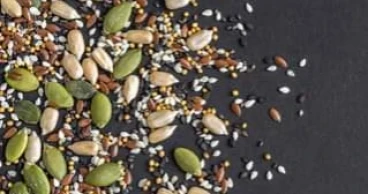Superfood
Microgreens: Nutrition, Health Benefits, and How to Grow
In a world where healthy eating and sustainable farming practices are gaining prominence, microgreens emerge as a nutritional powerhouse and an excellent addition to any diet. These tiny greens not only pack a punch in terms of health benefits but also offer a cost-effective solution for farming enthusiasts. This article will delve into the world of microgreens, their origins, health advantages, nutritional components, and how one can cultivate them in our country.
What are Microgreens?
Microgreens are the young, edible seedlings of various vegetables and herbs, tracing their roots back to California in the 1980s. Far from accidental, their invention resulted from meticulous research aimed at maximising the nutritional value of plants in their early growth stages.
Harvested at around 1-3 inches tall, one week aged, these tiny greens offer an incredible concentration of flavour and nutrients. They often contain 40 times more nutrients than their mature counterparts, making them a popular choice for those seeking both taste and health benefits. Easy to cultivate at home, microgreens have become a trendy and versatile culinary delight.
Read more: 10 Types of Natural Honey: A Guide to Varieties, Benefits, and Uses
Nutritional Components of Microgreens: Superfood of the Future
These seedlings are rich in a bunch of vitamins including Vitamin C, Vitamin K, Protein, Carbohydrates, Fibre, Sodium, Iron, Selenium, Magnesium, Manganese, etc.
Due to the high nutritional value, microgreens are also referred to as "superfood".
1 year ago
10 Types of Natural Honey: A Guide to Varieties, Benefits, and Uses
Honey, a revered golden elixir, has been celebrated for centuries across the globe, not just for its delightful sweetness but also for its remarkable nutritional and medicinal properties. This natural sweetener, crafted by bees from the nectar of various flowers, presents an array of types, each with its unique tapestry of flavors, origins, nutritional profiles, and health benefits.
Exploring Origins, Health Benefits, and Culinary Uses of Organic Honey
Himalayan Honey: A Mountain Treasure
Hailing from the majestic Himalayan region, which includes Nepal, India, Bhutan, and Tibet, Himalayan honey is derived from a diverse mix of wildflowers like rhododendron and wild cherry. This honey is not only a powerhouse of antioxidants but also enhances immune function, aids digestion, reduces inflammation, and combats fatigue. A local beekeeper says, "Himalayan honey's health-boosting properties are unparalleled."
Manuka Honey: New Zealand’s Healing Nectar
Originating predominantly from New Zealand, with some sources in Australia, Manuka honey is a product of the Manuka bush. Known for its high methylglyoxal content, it exhibits strong antibacterial qualities. It's widely used for healing wounds, bolstering the immune system, and fighting illness. Its antioxidant-rich profile makes it a staple for maintaining robust health.
Read more: Beekeepers in good spirit as Sundarbans sees honey boom
Clover Honey: Sweet and Beneficial
Clover honey, celebrated for its delectably sweet taste and rich antioxidant content, supports heart health and combats inflammation. Predominantly produced in clover-rich regions of Europe, New Zealand, and North America, it's gentle on the digestive system, making it an excellent addition to a health-conscious diet.
1 year ago
Superfoods: Worth the Hype?
In recent years, the term "superfood" has garnered significant attention in health and wellness. These foods are often touted as nutritional powerhouses. They are praised for their exceptional health benefits.
The buzz around superfoods stems from their purported ability to provide a high concentration of nutrients, antioxidants, and other health-promoting compounds. Now, the questions arise, what exactly qualifies as a superfood, and is the hype surrounding the superfoods justified?
Are Superfoods Worth the Hype?
Superfoods are nutrient-rich foods often hailed for their exceptional health benefits. They typically contain high levels of vitamins, minerals, antioxidants, and other essential nutrients that contribute to overall well-being. Superfoods include blueberries, spinach, salmon, chia seeds, and kale.
The term “superfoods” was coined in the 1990s. But it became widely familiar in 2007 after being mentioned in an article in Time Magazine. While the term "superfood" might spark intrigue, it is essential to approach the concept with a critical eye.
Read more: Popular Winter Breakfasts in Bangladesh
Scientific evidence supporting the extraordinary health claims of superfoods varies. While some foods offer remarkable nutritional values, others might not live up to the exaggerated claims. Assessing the actual worth of superfoods involves understanding their nutritional content, benefits, and limitations.
Tips for Incorporating Superfoods into Your Diet
Seeds as Garnish
Seeds like chia seeds, pumpkin seeds, and hemp seeds have gained attention as superfoods due to their rich nutrient profiles. They are packed with proteins, healthy fats, fibre, vitamins, and minerals.
These tiny seeds work excellently as garnishes. Their subtle taste makes them perfect for enhancing the nutritional value of dishes and snacks without overpowering the flavours.
Dark Chocolate Desserts
Contrary to popular belief, dark chocolate is a nutrient-rich superfood. It is abundant in antioxidants and various essential nutrients. It is a versatile ingredient for desserts and can serve as a flavour enhancer.
Read more: 10 Bangladeshi Winter Street Foods: Taste Meets Tradition
For instance, you may have strawberries or banana slices dipped in dark chocolate for an antioxidant-rich dessert. It offers a delicious pre-workout snack or an evening dessert.
Nuts as Snacks
Nuts are another nutrient-dense superfood group. It delivers proteins and omega-3 fatty acids and is ideal for plant-based diets. They make for a satisfying and healthier snack option between meals and keep hunger at bay. Nuts serve as a convenient way to boost nutrition and resist unhealthy snacking both at work or home .
Cauliflower Rice
Cauliflower is a superfood due to its nutrient content like protein, vitamins, and minerals. But it is often overlooked. Cauliflower can replace potatoes and is excellent as an alternative to regular or brown rice. To prepare cauliflower rice first, boil the florets, then cool them. Now process them in a mixer. Your cauliflower rice is ready to be savoured.
Read more: 5 Tasty Savoury Winter Pitha Recipes for Bangladeshi Kitchen
Yoghourt Desserts
Yoghourt is a versatile and nutrient-packed superfood that serves as a savoury side or a base for desserts. Yoghourt can be paired with granola, dark chocolate, or naturally sweet berries. It creates effortless and nutritious dessert cups.
Berries Candy
Berries such as strawberries and blueberries make a healthy substitute for candies. You need to transform them into candy-like treats by squeezing lemon over the berries and refrigerating them for a few hours. This trick works with citrus fruits like oranges too.
Green Iced Tea
For a refreshing and nutritious drink, you may try iced green tea. It is packed with nutrients and is known to boost metabolism. Green tea infused with ice, lemon, and honey offers a superfood-packed beverage.
Read more: 5 Tasty Sushi Recipes for Bangladeshi Kitchen
Garlic Olive Oil
Both garlic and olive oil qualify as superfoods. They are rich in nutrients and known for their healing properties. Creating garlic-infused olive oil serves as a healthier alternative to butter for toast toppings. You need to simply combine olive oil with peeled garlic cloves and bake to prepare this delicious garlic olive oil.
1 year ago
Top 10 Healthy Seeds to Eat
Nutrition plays significant roles for a human’s overall health and mental well-being. Adding seeds to one’s regular diet have numerous health benefits. Let’s discuss different types of seeds and their respective health benefits.
What Are Seeds?
All flowering plants reproduce through seeds. In simple words, a seed is the tiny, round or oval, hard component of a plant that works as the starting point of a new plant. More scientifically, a seed is a small embryonic ‘plant’, surrounded by a protective layer called the seed coat with certain reserved nutrients. In an appropriate environment, each seed has the potential to develop into a new plant.
How Seeds are Different from Nuts, Grains, and Beans
While many confuse seeds, nuts, grains, and beans; they are all different types of plant-based foods with unique characteristics. Though they share some similarities in terms of their nutritional content, they have differences.
Seeds are the reproductive parts of plants with high protein like chia seeds, sesame seeds. They are rich with healthy fats, fiber, vitamins and minerals.
Read More; Sweet Potato Health Benefits: The Organic Affordable Super Food
Nuts are the fruits of certain trees like almonds, peanuts. They are generally high with healthy fats, protein, fiber and various vitamins and minerals.
Grains are actually the seeds of grasses such as wheat, rice. They are a good source of carbohydrates, fiber, minerals and some essential vitamins.
Beans are the edible seeds of legume plants, such as lentils, kidney beans. Beans are nutritious with protein, fiber, various vitamins and minerals.
Each of these foods has unique properties that make them valuable additions to a healthy and varied diet.
Read More: Best and Worst Foods for Brain, Memory, Focus
How to Eat Seeds
Seeds are known as nutritional powerhouse. They are not just delicious and easy to consume but also convenient for people of all ages. Thus, just having proper digestion is not sufficient. It is vital to ensure that these nutrients are absorbed effectively by the body.
The next question that arises is the appropriate way to consume seeds. Eating them raw is the only way to derive nutrition from the seeds. It expands to soaked, ground or mashed particularly when added with other foods.
It is suggested to soak seeds overnight before consumption. Although soaking provides numerous benefits, the most significant is the removal of phytic acid found on them. Overnight soaking is the most effective method for this.
When selecting seeds, raw and unsalted varieties are recommended. Seeds, coated or roasted, or with added sugar coatings must be avoided.
read more: Natural Sweeteners: 7 Healthy Alternatives of Refined Sugar
10 Healthiest Seeds
Seeds may be small in size, but when it comes to nutrition it is packed with vitamins, minerals and healthy fats. This tiny powerhouse can provide the energy needed for the day ahead. In fact, seeds can be nutritious yet satisfying and a delicious filling snack. Here are the 10 healthiest seeds with benefits to boost overall health.
2 years ago
Beetroot: Nutrition, Health Benefits, Doses, Side Effects
Beetroot’s scientific name is Beta vulgaris. It is a root vegetable. It has numerous health benefits because of the huge amounts of phytochemical and nutritional components available in them. So, it is called functional food. Let’s check here the health benefits, uses, and side effects of beetroot.
Vitamins and Nutrients of Beetroot
Beetroot is a colorful vegetable that has carbohydrates, proteins, fats, fiber, and various types of vitamins and minerals also.
Per 100 grams of beetroot, you will get Calcium 8%, Vitamin C 4%, Iron 5%, Vitamin B6 5%, energy 43 kcal, Carbohydrates 9.56g, Proteins 1.61 g, Fibre 2.8 g, total fat 0.17g, Calcium 16g, Iron 0.8g, Magnesium 23 mg, Sodium 40mg, Potassium 325 mg, Phosphorous 40mg, Vitamin C 4.9mg, Thiamin 0.031mg, Riboflavin 0.4 mg, Folate 109 ¼ g, Vitamin B-6: 0.067 mg.
Read More: Superfood Moringa Powder: Know Its Health Benefits, Side Effects.
Top 10 Health Benefits of Beetroot
We have already got the nutritional value of beetroot, let's check out now the top health benefits of Beetroot.
Lower blood pressure
Beetroot naturally occurs in nitrates which are diverted into nitric oxide in the human body. This nitric oxide can relax and expand blood vessels and so helps to improve blood flow and reduce blood pressure. In fact, beetroot is an excellent source of blood pressure by lowering blood pressure within a couple of hours.
Grows stamina
The nitrates in beet get converted into nitric oxide in the human body which helps to reduce the potential amount of oxygen. This oxygen can be expended for low-intensity exercises and also increases tolerance to high-intensity exercises. Research has shown that people who eat beet juice just before taking exercise are able to exercise for a longer period of time.
Good for heart patients
Prominent amounts of triglycerides in your body cause consequential problems to the heart. Beetroot helps reduce triglycerides and cholesterol by increasing the amount of HDL cholesterol, namely good cholesterol. Besides, beetroot decreases the level of homocysteine as it contains the nutrient betaine. So, you can prevent the risk of heart attacks and strokes by taking beet regularly.
Reduce birth defects
Beets are packed with Vitamin B folates and so it helps to form a baby’s spinal column. So you can add beetroot to your diet if you are pregnant as folate deficiency can lead to a number of complications including defects in the neural tubes and ultimately defects in the brain, spine, or spinal cord. However, you need to consult with your doctor when you are pregnant.
Prevent cancer
The pigment betacyanins which are available in beetroot can prevent the growth of cancer cells. Beetroots are great to prevent colon, lung, and skin cancer. Meats are preserved using nitrates and the consumption of these meats may result in the formation of nitrosamine compounds in the body which ultimately leads to cancer. In this case, beetroot juice may reduce the cell mutations caused by these compounds.
Read more: Sweet Potato Health Benefits: The Organic Affordable Super Food
Beetroot juice for dementia
With age, the blood flow to certain areas of the brain decreases which can lead to loss of cognition and eventual dementia. Studies have shown that drinking beetroot juice can improve the supply of oxygen to your brain and slows the progression of dementia as beetroots have high nitrate concentration.
2 years ago
Superfood Moringa Powder: Know Its Health Benefits, Side Effects
Moringa, also known as drumstick tree is a plant native to India, Africa, and other countries. People use it for centuries because of its medicinal properties and health benefits. Maybe you have the question: Is Moringa power the new superfood? Yes, recently it has gained the reputation of being a superfood having amazing health benefits. Stay with us to explore the benefits and risks of moringa powder.
Health Benefits of Moringa Powder Consumption
Nutrient-rich plants
You eat many healthy foods but most of them have only one or two nutrients. On the contrary, Moringa is:
-25% plant protein including all 9 essential amino acids
-24% fiber
-A rich source of iron, vitamin K & E, vitamin C, A, B6, and riboflavin
-A source of calcium, potassium, magnesium
-High in antioxidants
Because of these nutrients, it is highly bioavailable. So our bodies can absorb the benefits easily. It has a delicious spinachy green flavor and you can use it in curries, stews, casseroles, soups, salads, and green smoothies.
Read Magical Benefits of Himalayan Pink Salt
Protect the liver
The liver is the detoxifier of your body which filters the blood, detoxifies chemicals, and metabolizes fat. The amazing thing is that moringa may help the Liver work better. Moringa contains huge amounts of polyphenols to alter oxidation in the liver. Moreover, research has shown regular consumption of moringa help to reduce liver fibrosis and protect against liver damage.
Improves bone health
Moringa leaves are packed with calcium and phosphorus and these elements are really good for good bone health. Moringa leaves have an anti-inflammatory nature that fights arthritis and may even heal damaged bones. Moreover, Moringa fights against osteoporosis and that naturally makes bone and teeth strong.
Nervous system
Moringa leaves work positively for many nervous disorders. They amazingly support brain health by working as neuro-enhancers. It contains vitamins E and C that fight neural degeneration and helps improve brain function. If you suffer from a migraine or recurring headaches, you must eat moringa leaves regularly.
Read Intermittent Fasting: Health Benefits and Risks
Reduce inflammation
After turmeric, moringa is a new inflammation-fighter for you. Moringa notably lower inflammation in cells. It contains inflammation-lowering polyphenols and isothiocyanates that reduce inflammation by suppressing inflammatory enzymes and proteins in the body. Eventually, work on the case of diabetes, cardiovascular disease, and cancer.
Balance blood sugar
Spit in insulin and blood sugar levels cause mood swings and sugar yearnings and that ultimately leads to the development of type 2 diabetes and obesity. The moringa leaf powder is really effective to reduce lipid and glucose levels and regulating oxidative stress in lab studies.
One clinical study has shown that regular taking moringa supplements can improve therapeutic antioxidant properties and lower fasting glucose levels in postmenopausal women. Besides, if you put moringa in the diet, it could help reduce weight gain and insulin resistance.
Read Health Benefits of Different Types of Nuts
Improve digestion
Moringa leaf powder contains about 30% fiber that helps digestion as well as reduces your risk of disease. Above all, moringa is a natural antibiotic and antibacterial which help hinder the growth of various pathogens that can cause digestive upset. Moringa has anti-inflammatory properties that help with digestive disorders and may improve gut bacteria.
Support brain health
A study has shown that every one in eight people over the age of 65 have Alzheimer's disease. For them, moringa leaf powder is great by contains vitamins C and E, which combat the oxidative stress related to Alzheimer's. Moreover, moringa increases dopamine and serotonin-happy hormones that eventually could be used to help treat depression in the future.
Read Oolong Tea: Health Benefits, Nutrients and Risks
Skin-friendly
Maringa is full of skin-loving vitamins:
-Vitamin A: 18.9% of NRV: essential for healthy and radiant skin
-Vitamin E: 16.9% of NRV: protects cells from oxidative stress and ultimately helps fight the signs of aging.
Promotes Immunity
Moringa is well known for its super immune-boosting powers. You need to maintain a healthy immune system to help your body stave off infections and illnesses. Moringa contains:
-Iron: 32.2% of NRV
-Vitamin A: 18.9% of NRV
Both Iron and Vitamin A are essential for the normal function of the immune system. Besides, many studies have shown that moringa works as an anti-cancer agent. Moringa leaves can fight against both breast and colon cancer cells and research is ongoing.
Read Ketogenic Diet: Know the benefits and risks
How to create Moringa Powder
If you want to prepare your moringa powder, just follow the given steps below:
Step 1: Cut your moringa tree or one branch
Step 2: Collect the moringa leaves
Step 3: Prepare for drying the leaves
Step 4: Collect the dried moringa leaves
Step 5: Blend the dried moringa leaves
Step 6: Strain well and refine
Step 7: Once prepare you can store it to eat or drink. You can also share it with the nearest one or sell it.
However, if you don’t like hazardous work like preparing moringa power by yourself, you can buy it from the grocery store. Besides, it is available online also to buy anytime, anyplace.
Read Panta Bhat: The Amazing Health Benefits of Water Rice
How to use moringa powder
You have already prepared moringa powder from dried and ground moringa leaves. So, it is ready to use. You will love the powder as it has a mild flavor with a slightly earthy taste. You can use it with many different recipes.
If you are trying to lose some extra pounds, then don’t forget to add it to your morning green smoothie. This superfood will improve your digestion power.
You can also use it in hummus, guacamole, soups, salads, avocado toast, or sweet potato toast for lunches or other meals.
Besides, it would be very good if you can use it in your favorite energy balls.
Most importantly, you can use it as a caffeine-free coffee substitute by whisking it into hot water.
Read Omega-3 Fatty Acids and Fish Oil: Natural Sources, Benefits, Risks
Side Effects of Moringa Powder
If you want to consume moringa powder on a regular basis, talk to your doctor or dietitian.
Moringa may contain anti-fertility qualities. Therefore, Moringa Powder is not recommended for pregnant mothers.
You need to read the label while using purchased Moringa powder and follow instructions.
When you are on medication related to Thyroid, Diabetic, Hyper-tension or any other disease do not consume moringa powder without a doctor’s approval. Otherwise, it can pose serious risks to your health.
Bottom Line
Mother nature is full of wonder, blessings, and natural remedies, and Moringa is one of those. Our above-mentioned health benefits and side effects of Moringa Powder will help you always to detect whether you should consume moringa regularly. If your doctor allows, try moringa today following our preparation steps. Hope this superfood will help you stay away from many diseases.
Read Dark Chocolate: Health Benefits, Nutrition, Side Effects
3 years ago










